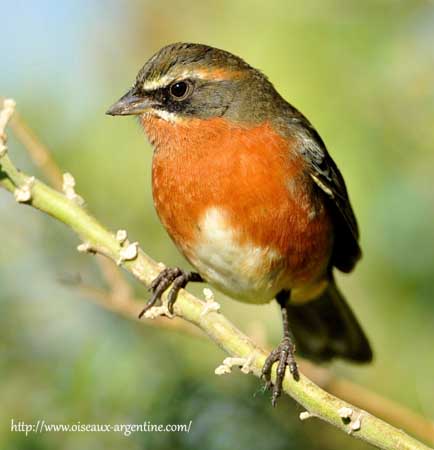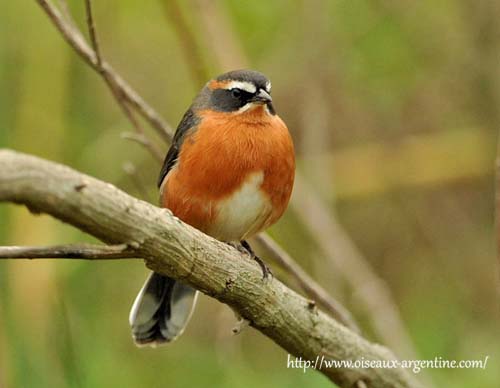
Fr: Chipiu noiroux
All: Rotbrust-Ammerfink
Esp: Dominiquí Sietevestidos
Ital: Fringuello cantore nero e ruggine
Nd: Zwart-rosse Boomgors
Sd: Svartröd sångfink
Port: Quem-te-vestiu
Photographers:
Philippe and Aline Wolfer
OISEAUX D'ARGENTINE
Text by Nicole Bouglouan
Sources:
HANDBOOK OF THE BIRDS OF THE WORLD Vol 16 by Josep del Hoyo- Andrew Elliot-David Christie – Lynx Edicions – ISBN: 9788496553781
BIRDS OF SOUTH AMERICA – Passerines - by Robert S. Ridgely and Guy Tudor – HELM Field Guides – ISBN: 9781408113424
BirdLife International (BirdLife International)
Arthur Grosset's Birds (Arthur Grosset)
Black-and-rufous Warbling-Finch
Poospiza nigrorufa
Passeriforme Order – Thraupidae Family
BIOMETRICS:
Length: 15 cm
Weight: 13-20 g
DESCRIPTION:
The Black-and-rufous Warbling-Finch is a South American species which name comes from its sweet, pleasant and melodious song and its bright-coloured plumage.
The adult male of nominate race (here displayed) has brownish-grey nape, upperparts and upperwing. The tail is dusky with partially white-tipped outer rectrices.
On the underparts, chin, throat and breast are rufous, like most parts of the underparts, except lower belly and vent which are buffy-white. Middle of belly is white, extending to the lower breast in inverted V-shape. Flanks are tinged brown.
On the head, crown and face are blackish. There is a long, narrow, white supercilium, becoming paler rufous behind the eye. A narrow, white submoustachial stripe contrasts with rufous underparts.
The rather long, pointed bill is dark grey with darker culmen and tip. Eyes are dark brown. Legs and feet are blackish.
Both sexes are similar.

The juvenile is much duller than adults. The white and cinnamon supercilium is indistinct and whitish. Underparts are creamy-white and heavily streaked brown. Later, a rufous wash may be visible on breast and flanks.
The immature resembles adults, but it is slightly spotted white on the darkest parts.
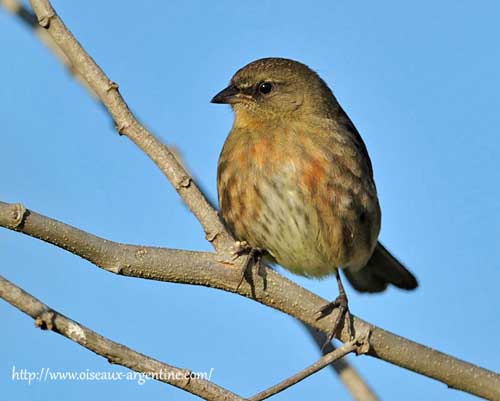
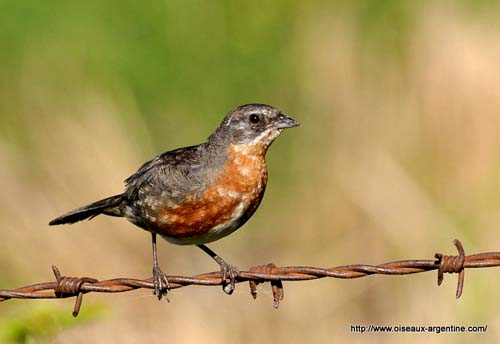
We can find three subspecies:
P.n. wagneri occurs in La Paz in W Bolivia. This race has more extensive white moustache.
P.n. whitii is found in Bolivia and NC Argentina. This one is mostly slate-grey above and darker chestnut below, with less white on belly. Outer rectrices show more extended white at tips.
P.n. nigrorufa (here described) is found in SE Brazil, Uruguay and NE Argentina. Non-breeding birds can be seen in SE Paraguay.
VOICE: SOUNDS BY XENO-CANTO
The Black-and-rufous Warbling-Finch utters rapid, repeated “swit-swit-cheuu, swit-swit-cheuu…” as song. There are usually four phrases, and the song ends with a “swee?”
The song of race “whitii” is slower and lower-pitched, more variable and complex, mainly a continuous song including “tip-tip” and low, quavering “pweerrr”.
The main call is a high-pitched “tziip”.
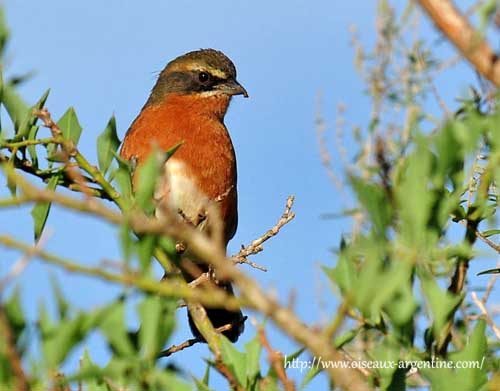
HABITAT:
The Black-and-rufous Warbling-Finch frequents shrubby areas and woodlands in grassy pampas, also close to marshes, bushy areas near water and suburban areas including gardens. It can be seen from sea-level up to 500 metres of elevation.
The race “whitii” frequents shrubby thickets, roadsides’ clumps of trees, and highland cultivated areas with adjacent shrubby areas. It is visible between 600 and 2500 metres of elevation.
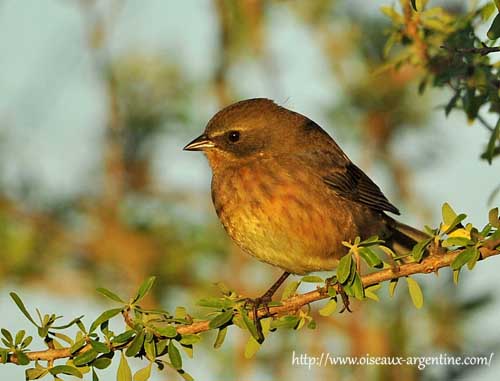
RANGE:
See above in “subspecies”
BEHAVIOUR:
The Black-and-rufous Warbling-Finch is not very conspicuous, and more often heard than seen. It is often seen alone or in pairs, foraging on the ground or in low vegetation. It feeds mainly on seeds and berries. It hops and runs, and prefers to reach the vegetal cover rather than to take flight.
It may occasionally follow army ants. During the nesting period, the chicks are fed with invertebrates.
The breeding season is linked with the rainy season. This species is monogamous. The male is territorial and performs mate-guarding during the egg-laying, in order to chase away from the nest-site all potential rivals.
It probably performs flight displays while singing.
During courtship, some postures enhance the head pattern and the bright-coloured underparts.
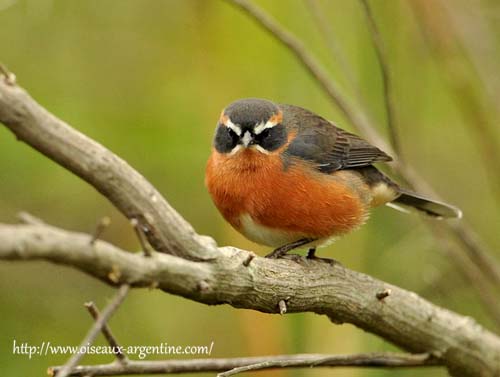
The Black-and-rufous Warbling-Finch is largely sedentary in its range. Some birds can be partial migrants during austral winter, moving to Paraguay.
The race “whitii” performs seasonal movements in dry parts of the range.
FLIGHT:
The Black-and-rufous Warbling-Finch has direct, slightly undulating flight over long distances, but within shrubby areas, it performs brief bursts of flapping.
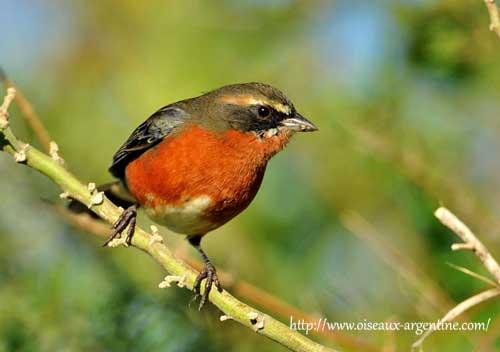
REPRODUCTION:
The breeding season varies according to the range, with nests between October and January in NE Argentina.
The nest is built mainly by the female. This is a cup made with dry grasses and twigs, and lined with softer materials such as feathers and spider webs. The nest is placed in thick shrubs, usually low, at about one metre above the ground. Such nest may sometimes be woven in with leaves in shrubbery.
The female lays 3-4 pale blue eggs with dark markings. She incubates during 14 days. Only the female develops an incubation patch. However, the chicks are fed by both parents, and leave the nest 16 days after hatching.
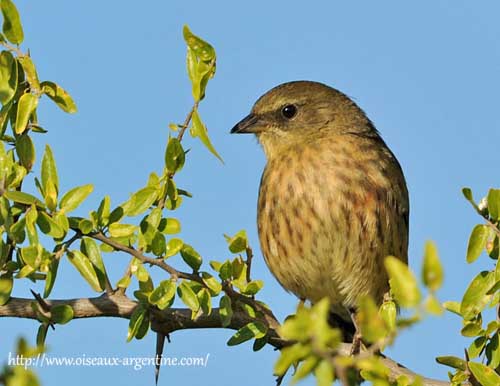
DIET:
The Black-and-rufous Warbling-Finch feeds mainly on seeds and berries. It forages on and near the ground, by hopping and running.
PROTECTION / THREATS / STATUS:
The Black-and-rufous Warbling-Finch of nominate race is common in its range. The race “whitii” is fairly common in most part of the range, but uncommon in the northern parts. The race “wagneri” is uncommon.
But this species is not currently threatened.
